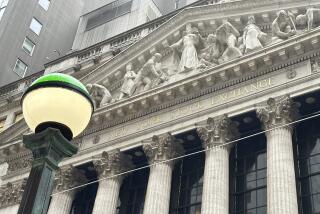Bonds’ Steady Pace Faces New Hurdles
- Share via
Most people who hold bonds or bond mutual funds own them to avoid or offset the risk of owning stocks.
It’s a strategy that has worked wonderfully in 2001. While the stock market has plunged, high-quality government and corporate bonds produced positive total returns in the range of 4% to 10% through the first nine months.
For bond investors, slow but steady--the tortoise approach--has won the race this year. People who viewed bonds as hopelessly boring in the late 1990s suddenly appreciate what these corporate or government IOUs can do for a portfolio.
But veteran bond owners and potential new buyers alike now face a tough decision: With yields on some Treasury securities lower than at any time since the Eisenhower administration, bonds would seem to have much less potential to produce decent returns in the next few years.
What’s more, if market interest rates should rebound sharply with a recovering economy, investors who buy bonds today would not just be stuck with poor yields; they also could face heavy paper losses on their securities.
That’s because a bond or bond mutual fund’s total return is more than just the interest it pays. Also included in that return calculation is how the market price of a bond or fund fluctuates.
When market yields are dropping, as they have this year amid a weak economy and extraordinary credit-easing by the Federal Reserve, older bonds issued at higher rates automatically rise in value.
The flip side is true when market yields are rising: Older bonds at lower fixed rates decline in value.
Through the first nine months of this year, ended Friday, the average long-term government bond fund produced a total return of 6.3%, according to fund-tracker Morningstar Inc. in Chicago. About 40% of that return was price appreciation; the rest was interest income.
By contrast, what has happened with corporate junk bonds this year demonstrates the risk inherent in bond investing.
Investors have fled low-quality junk issues, fearing rising default rates by companies in a weak economy. As the bonds’ prices have tumbled, the losses have more than offset interest earned.
The average junk bond fund’s total return is a negative 4.1% so far this year, including a 5.1% decline in the third quarter alone. That, despite annualized interest payments of 11% or more on the average junk bond.
Still, many economists and money managers don’t believe that low yields on Treasury issues and other high-quality bonds necessarily face a dramatic rebound soon.
The stagnant global economy and the anxiety brought on by the Sept. 11 terrorist attacks probably will keep Treasury yields low at least into the new year, such observers say.
“I don’t think it’s madness for rates to be so low,” said Dana Johnson, research director for Bank One Capital Markets in Chicago. “The economy is going to struggle here, and there’s a chance that short-term and long-term yields could go a bit lower.”
For the most safety-conscious investors, the performance their bonds have delivered this year--capital gains in addition to interest income--has been icing on the cake. These investors wanted protection for their savings first and foremost, and they got it.
What may surprise them--and others who are less averse to risk--is that government bond funds’ three-year average annualized returns now are slightly higher than the 4% annualized return of the average U.S. stock fund in the period.
In theory, stocks are riskier and therefore should produce higher returns than government bonds in the long run. But measuring back three years that hasn’t been the case.
Stock market bulls say it’s only a matter of time. They expect the Federal Reserve’s aggressive interest rate cutting and the Bush administration’s tax cuts and government spending initiatives to get the economy rolling again in 2002. If so, the stock market will take off and leave bond returns in the dust again, they say.
Even financial advisors who believe bond yields could stay low for a while caution investors who hold mostly stocks and have been watching the bond market with envy this year: It’s often dangerous to “chase” performance by shifting large sums from an area that has been cold into one that has been hot, they note.
“It’s the wrong time to be layering in a lot of extra bonds,” Johnson said. “That horse has already bolted.”
It has been a nice ride for those who got in early enough, however:
* Intermediate-and long-term government bond funds led all bond fund categories in the third quarter, posting average total returns of 4.5% and 5.4%, respectively, according to Morningstar.
* Investment-grade bond funds --which mostly own high-quality corporate issues--also produced third-quarter returns in the 3% to 4% range.
* Municipal bond fund returns averaged 2% to 4% in the quarter, but those numbers understate muni funds’ true returns because the interest the bonds pay is exempt from federal (and often state) income tax.
Some bond market pros say investors who want to buy bonds now should concentrate on sectors other than Treasuries.
“Spreads” between the yields of Treasuries and corporate bonds of the same maturity have been widening since Sept. 11, reflecting the risk of a weaker economy hurting corporate issuers, plus the extra premium investors will pay for the added security of the U.S. government guarantee, especially during wartime.
Robert V. DiClemente, chief economist at Salomon Smith Barney, believes that Treasury yields have gone about as low as they will go.
“There’s no value in Treasuries, to put it bluntly,” he said. “The only reason for holding them is out of fear.”
Salomon has been recommending high-rated corporate bonds as a good value, arguing that an economic rebound would quickly bolster profits for strong companies, underpinning the value of their bonds.
But the Sept. 11 attack “pulled the rug out from under us a little bit,” DiClemente said.
The uncertainty following the attacks makes it hard for DiClemente to recommend that buyers should rush into corporate bonds, but he believes there are excellent values in that sector.
“The minute you turn the page and say you’re willing to take a little risk, you have an open field” in the bond market today, he said.
Better-quality companies have used the credit-easing cycle that began in January as an opportunity to repair their balance sheets, restructuring and reducing debt, DiClemente said. Bonds of such firms already are good values and will be recognized as such as soon as the blanket of fear lifts, he said.
Municipal bonds, with their tax-exempt status, always are a popular alternative for investors. However, the revenues of some muni bond issuers lately are coming under even greater pressure than those of corporations, said R. Alan Medaugh, president of International Strategy & Investment Group in New York.
Take the state of Tennessee, admired in recent years for strong growth, relatively low taxes and a triple-A bond rating from the top rating agencies, Moody’s Investors Service and Standard & Poor’s.
But the economic slump has exposed Tennessee’s vulnerability in a key area, Medaugh said: “The majority of its revenue comes from the sales tax. Now all of a sudden--no sales.”
The state used its share of the giant tobacco legal settlement to balance its budget this year, but because of continuing fiscal problems, “Moody’s and S&P; took them to double-A in nothing flat,” Medaugh said.
Some states, their treasuries flush from the economic boom, rushed to distribute their budget surpluses to taxpayers through special rebates, leaving little fiscal cushion for the lean times that have arrived.
Though actual muni bond defaults are rare, the bonds’ prices can swing based on the market’s perception of their quality, experts say.
Of course, investors who buy individual bonds may not care about market price swings if they plan to hold the bonds until they mature. At that point, the full face value of a bond is returned to its owner.
But bond mutual funds are open-ended, meaning they have no maturity date. So price swings of bonds in a fund are reflected in the fund’s share value.
Investors who are wary of bonds in general at today’s yields, but who want to shift more of their portfolio to bonds in the long run, have a simple option, financial advisors say: Rather than move a large chunk of assets into bonds now, plan to buy gradually over the next year or so.
If interest rates begin to rise in 2002, buying bonds over time will allow investors to snare higher yields as they go along.
*
Thomas S. Mulligan can be reached at [email protected].
*
TOP-RATED BOND FUNDS
Bond funds, ranked according to a system developed by The Times and fund tracker Morningstar Inc., are listed in more than a dozen categories beginning on S8.
(BEGIN TEXT OF INFOBOX / INFOGRAPHIC)
Bond Fund Performance by Morningstar Category
(tabular data not included)
(BEGIN TEXT OF INFOBOX / INFOGRAPHIC)
Performance of Largest and 401(k)-Favorite Mutual Funds
(tabular data not included)
(BEGIN TEXT OF INFOBOX / INFOGRAPHIC)
Large Growth Funds Ranked by Third-Quarter Return
(tabular data not included)
More to Read
Inside the business of entertainment
The Wide Shot brings you news, analysis and insights on everything from streaming wars to production — and what it all means for the future.
You may occasionally receive promotional content from the Los Angeles Times.










